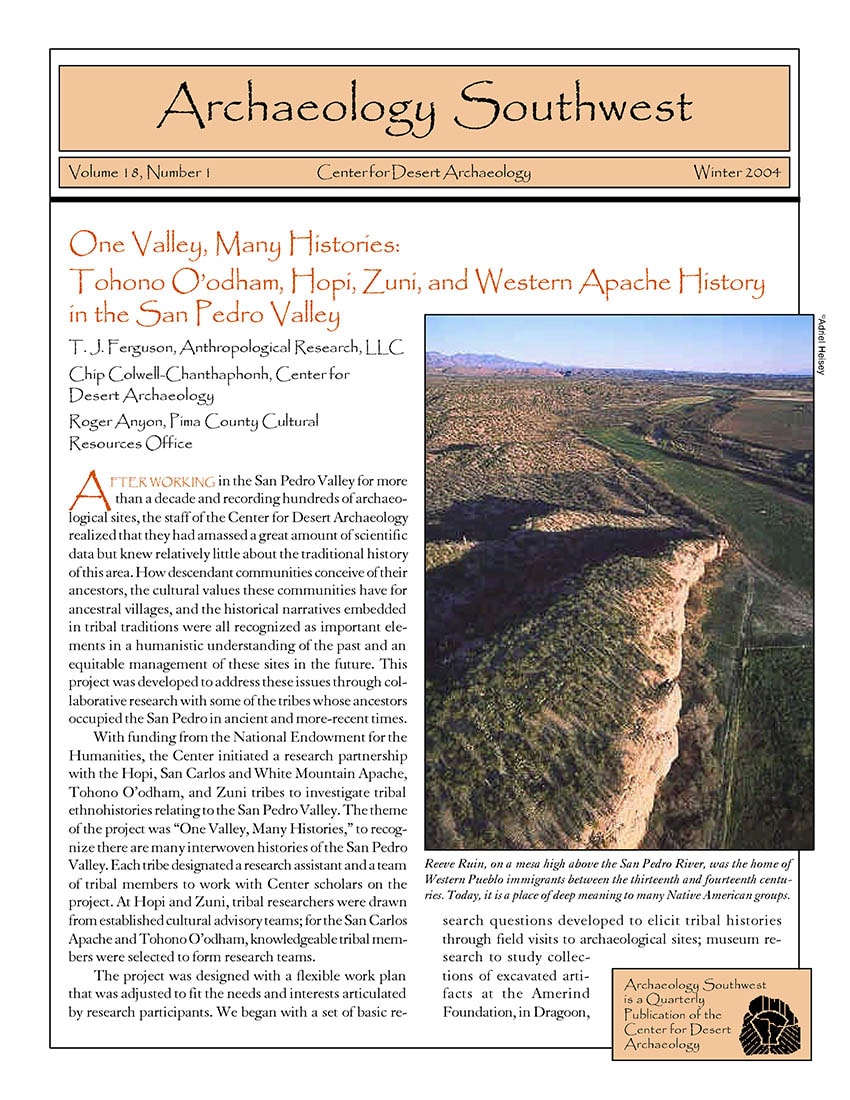One Valley, Many Histories: Tohono O’odham, Hopi, Zuni, and Western Apache History in the San Pedro Valley

Reeve Ruin, on a mesa high above the San Pedro River, was the home of Western Pueblo immigrants in the thirteenth and fourteenth centuries. Today, it is a place of deep meaning to many Native American groups. Photograph © Adriel Heisey.
Archaeology Southwest Magazine Vol. 18, No. 1
FREE PDF DOWNLOAD
T. J. Ferguson, Anthropological Research, LLC
Chip Colwell-Chanthaphonh, Archaeology Southwest (formerly the Center for Desert Archaeology)
Roger Anyon, Pima County Cultural Resources Office
After working in the San Pedro Valley for more than a decade and recording hundreds of archaeological sites, the staff of the Center for Desert Archaeology realized that they had amassed a great amount of scientific data but knew relatively little about the traditional history of this area. How descendant communities conceive of their ancestors, the cultural values these communities have for ancestral villages, and the historical narratives embedded in tribal traditions were all recognized as important elements in a humanistic understanding of the past and an equitable management of these sites in the future. This project was developed to address these issues through collaborative research with some of the tribes whose ancestors occupied the San Pedro in ancient and more-recent times.
With funding from the National Endowment for the Humanities, the Center initiated a research partnership with the Hopi, San Carlos and White Mountain Apache, Tohono O’odham, and Zuni tribes to investigate tribal ethnohistories relating to the San Pedro Valley. The theme of the project was “One Valley, Many Histories,” to recognize there are many interwoven histories of the San Pedro Valley. Each tribe designated a research assistant and a team of tribal members to work with Center scholars on the project. At Hopi and Zuni, tribal researchers were drawn from established cultural advisory teams; for the San Carlos Apache and Tohono O’odham, knowledgeable tribal members were selected to form research teams.
The project was designed with a flexible work plan that was adjusted to fit the needs and interests articulated by research participants. We began with a set of basic research questions developed to elicit tribal histories through field visits to archaeological sites; museum research to study collections of excavated artifacts at the Amerind Foundation, in Dragoon, Arizona, and the Arizona State Museum, in Tucson; and oral history interviews with tribal members. During the project, the research design was modified to accommodate the suggestions and questions of different tribal research teams. Numerous meetings were held with tribal representatives to ensure the research was conducted in a culturally appropriate manner and to review project results. A longer technical report on the San Pedro Ethnohistory Project is being prepared and will be available in 2004.
During fieldwork, close attention was paid to how the landscape was used to talk about tribal history, how sites constitute monuments, and how artifacts are used to recall the past. Our colleagues in the tribal research teams explained how all these forms of memory create vital connections between past and present native peoples. These issues are woven together in this issue of Archaeology Southwest. Native American perspectives add an essential component to our knowledge of the archaeology and history of the San Pedro Valley, as well as to our understanding of why ancient sites are still important today.
Articles include:
A Mosaic of Land, History, and Culture
Archaeology of the San Pedro River Valley — Patrick D. Lyons, Center for Desert Archaeology
Archaeological Timeline for the San Pedro Valley
“Our Cousins to the East”: O’odham Traditions in the San Pedro Valley
The Village of Gaybanipitea
The Lost Others: Zuni Ancestors Who Journeyed South
Vandalism in the San Pedro Valley
Landscapes of a Living Past: Places of Western Apache History
Naming Places
Ang Kuktota: Hopi Footprints in the San Pedro Valley
A Ceremonial Kiva in Southern Arizona
Models of Ethnogenesis
Remembering the Ancestors
Back Sight — William H. Doelle
Subscribe

